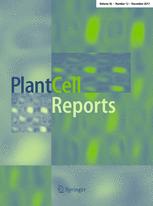View Item
- xmlui.general.dspace_homeCentros Regionales y EEAsCentro Regional Buenos Aires NorteEEA San PedroArtículos científicosxmlui.ArtifactBrowser.ItemViewer.trail
- DSpace Home
- Centros Regionales y EEAs
- Centro Regional Buenos Aires Norte
- EEA San Pedro
- Artículos científicos
- View Item
Cell wall-related genes studies on peach cultivars with differential susceptibility to woolliness: looking for candidates as indicators of chilling tolerance
Abstract
The storage of peaches at low temperatures for prolonged periods can induce a form of chilling injury (CI) called woolliness, characterized by a lack of juiciness and a mealy texture. As this disorder has been associated with abnormal cell wall dismantling, the levels of 12 transcripts encoding proteins involved in cell wall metabolism were analysed in cultivars with contrasting susceptibility to this disorder selected from five melting flesh peach
[ver mas...]
The storage of peaches at low temperatures for prolonged periods can induce a form of chilling injury (CI) called woolliness, characterized by a lack of juiciness and a mealy texture. As this disorder has been associated with abnormal cell wall dismantling, the levels of 12 transcripts encoding proteins involved in cell wall metabolism were analysed in cultivars with contrasting susceptibility to this disorder selected from five melting flesh peach cultivars. The resistant (‘Springlady’) and susceptible (‘Flordaking’) cultivars displayed differences in the level of expression of some of the selected genes during fruit softening and in woolly versus non-woolly fruits. From these genes, the level of expression of PpXyl, which encodes for a putative β-xylosidase, was the one that presented the highest correlation (negative) with the susceptibility to woolliness. PpXyl expression was also analysed in a cultivar (‘Rojo 2’) with intermediate susceptibility to woolliness, reinforcing the conclusion about the correlation of PpXyl expression to the presence of woolliness symptom. Moreover, the level of expression of PpXyl correlated to protein level detected by Western blot. Analyses of the promoter region of the PpXyl gene (1637 bp) isolated from the three cultivars showed no differences suggesting that cis-elements from other regions of the genome and/or trans elements could be responsible of the differential PpXyl expression patterns. Overall, the results obtained indicate that PpXyl may act as a good indicator of woolliness tolerance and that the regulation of expression of this gene in different cultivars does not depend on sequences upstream the coding sequence.
[Cerrar]

Author
Genero, Melisa;
Gismondi, Mauro;
Monti, Laura;
Gabilondo, Julieta;
Budde, Claudio Olaf;
Andreo, Carlos Santiago;
Lara, María Valeria;
Drincovich, María Fabiana;
Bustamante, Claudia Anabel;
Fuente
Plant cell reports 35 (6) : 1235–1246. (June 2016)
Date
2016-02-23
ISSN
1432-203X
Formato
pdf
Tipo de documento
artículo
Palabras Claves
Derechos de acceso
Abierto
 Excepto donde se diga explicitamente, este item se publica bajo la siguiente descripción: Creative Commons Attribution-NonCommercial-ShareAlike 2.5 Unported (CC BY-NC-SA 2.5)
Excepto donde se diga explicitamente, este item se publica bajo la siguiente descripción: Creative Commons Attribution-NonCommercial-ShareAlike 2.5 Unported (CC BY-NC-SA 2.5)


